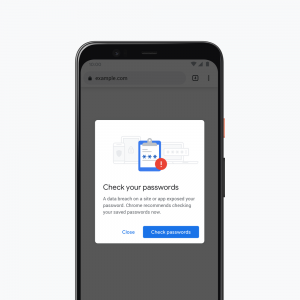 APPS
APPS
 APPS
APPS
 APPS
APPS
Google LLC today released a new version of its popular Chrome browser complete with a range of new security features designed to make the browsing experience safer.
 For one, Chrome 79 integrates Password Checkup, a feature previously available as a plugin as standard in the browser.
For one, Chrome 79 integrates Password Checkup, a feature previously available as a plugin as standard in the browser.
The service checks login details and tells users if their username and passwords have been compromised in a data breach on a site or app. When a compromised password is detected, the feature then recommends that users immediately change the password.
The new version of Chrome also offers new real-time phishing protection that expands on Google’s existing Safe Browsing feature that blocks unsafe sites. The previous technology would check against a list of unsafe sites and warn users before entering.
By contrast, the new services analyzes the URLs of pages as they’re visited against a list of thousands of popular sites in an effort to detect potentially malicious sites.
“We’re noticing that some phishing sites slip through our 30-minute refresh window, either by switching domains very quickly or by hiding from Google’s crawlers,” Patrick Nepper, Kiran C. Nair, Vasilii Sukhanov and Varun Khaneja of Google’s Chrome Team wrote in a blog post. “That’s where real-time phishing protections come in.” In testing, Google said, real-time phishing protection has seen a 30% increase in protecting users by warning them of malicious sites that are new.
Predictive phishing protection, a service that previously existed, has been expanded to all users signed into Chrome along with added support for all passwords stored in Chrome’s password manager. If users types a protected password into an unusual site, Chrome classifies the action as a potentially dangerous event, providing a warning and suggesting that they change their password.
Google also sneaked in a few new non-security-related features into Chrome 79 as well with a new feature called “Proactive Tab Freeze.” The feature, as its name suggests, will freeze tabs that have not been used for five minutes in order to reduce processor and memory usage and hence battery use.
Also aimed at reducing processor, memory and power usage is a new feature called back-forward cache. It creates a special cache for the back and forward Chrome buttons that cache a copy of pages on either side of a current page so if a user goes back or forward the page is loaded from cache, improving loading times and resource use.
Other new features include support for WebXR Device API, a feature the delivers a virtual reality experience to the web, a new user interface for the Chrome Profile section and support for maskable icons in the Android version.
The update is being pushed out to all Chrome users on Windows, macOS, iOS, Android and Linux in coming days.
Support our open free content by sharing and engaging with our content and community.
Where Technology Leaders Connect, Share Intelligence & Create Opportunities
SiliconANGLE Media is a recognized leader in digital media innovation serving innovative audiences and brands, bringing together cutting-edge technology, influential content, strategic insights and real-time audience engagement. As the parent company of SiliconANGLE, theCUBE Network, theCUBE Research, CUBE365, theCUBE AI and theCUBE SuperStudios — such as those established in Silicon Valley and the New York Stock Exchange (NYSE) — SiliconANGLE Media operates at the intersection of media, technology, and AI. .
Founded by tech visionaries John Furrier and Dave Vellante, SiliconANGLE Media has built a powerful ecosystem of industry-leading digital media brands, with a reach of 15+ million elite tech professionals. The company’s new, proprietary theCUBE AI Video cloud is breaking ground in audience interaction, leveraging theCUBEai.com neural network to help technology companies make data-driven decisions and stay at the forefront of industry conversations.